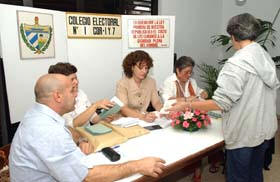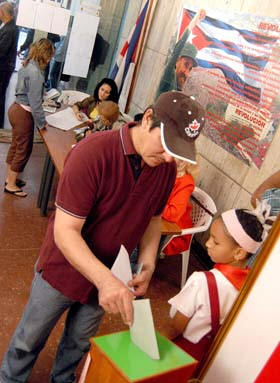GRANMA
January 26, 2008
Elections in Cuba
The Revolution
By

Reus,
 The
minister described
The
minister described
She noted that,
She said the
Lazaro Barredo,
Extensive Consultations
Alberto
He said provincial
He said
GRANMA
Nuestro pueblo jamás entregará la Revolución
y el Socialismo
Dan a conocer resultados oficiales de los sufragios del 20 de enero. Trabajan en proyectos de candidaturas con vistas a la elección de las direcciones de las asambleas Nacional y Provinciales y de los integrantes del Consejo de Estado
María Julia
Mayoral
ma.julia@granma.cip.cu
 Comprobados y validados
por la Comisión Electoral Nacional, los resultados de los comicios de
este 20 de enero arrojan que 8 231 365 cubanos acudieron a las urnas, el
96,89% de los inscritos, para confirmar, como ha dicho Fidel, que este
pueblo no entregará jamás la Revolución y el Socialismo, ni entregará
jamás sus armas y su unidad.
Comprobados y validados
por la Comisión Electoral Nacional, los resultados de los comicios de
este 20 de enero arrojan que 8 231 365 cubanos acudieron a las urnas, el
96,89% de los inscritos, para confirmar, como ha dicho Fidel, que este
pueblo no entregará jamás la Revolución y el Socialismo, ni entregará
jamás sus armas y su unidad.
Los concurrentes a las urnas, mayoritariamente, se caracterizaron por una elevada calidad de los sufragios: de las boletas depositadas, un total de 7 839 358 (95,24%) resultaron válidas, y dentro de estas el 91% (7 125 752) respondió al voto unido por todos los candidatos a diputados y a delegados provinciales. Las otras boletas válidas (713 606, equivalentes al 9%) correspondieron al voto selectivo, anunció María Esther Reus, presidenta de la Comisión Electoral Nacional, en la Mesa Redonda Informativa de este viernes.
La también Ministra de Justicia comunicó que las boletas depositadas en blanco representaron el 3,73% (306 791) y las anuladas, el 1,04% (85 216).
 Consideró asimismo que la
elección de los 614 diputados y de los 1 201 delegados provinciales
constituyó un rotundo éxito al poner de manifiesto las motivaciones del
pueblo, la naturaleza participativa de los comicios en Cuba, la
transparencia y la profesionalidad de las autoridades electorales,
quienes contaron con el apoyo de numerosos colaboradores en las tareas
del aseguramiento material.
Consideró asimismo que la
elección de los 614 diputados y de los 1 201 delegados provinciales
constituyó un rotundo éxito al poner de manifiesto las motivaciones del
pueblo, la naturaleza participativa de los comicios en Cuba, la
transparencia y la profesionalidad de las autoridades electorales,
quienes contaron con el apoyo de numerosos colaboradores en las tareas
del aseguramiento material.
Según refirió, los resultados oficiales están respaldados por un minucioso trabajo de revisión de las votaciones y de compatibilización con el Registro Electoral, como exige la legislación vigente.
El empleo de la informatización, dijo, permitió que por primera vez las inscripciones excepcionales (IE) fueran computadas y conciliadas no solo a escala nacional, sino también provincia por provincia.
Esto quiere decir, sustentó, que gracias a las facilidades brindadas por la informática pudo contabilizarse con precisión cuáles fueron las personas que hicieron uso de la IE (votar en colegio distinto al suyo por razones justificadas) e incluir a esos electores en el cálculo del porcentaje de asistencia a las urnas de su territorio de origen, como un paso de avance en el grado de precisión de los cómputos.
Mediante la aplicación del software creado por especialistas cubanos, también resultó más fácil el proceso de actualización de las listas de electores durante el transcurso de los sufragios, lo que incluyó las incorporaciones ordinarias y las excepcionales, y las bajas por fallecimiento.
Para el diputado Lázaro Barredo, director del periódico Granma, lo ocurrido este 20 de enero puso en evidencia la total libertad de los cubanos a la hora de expresarse en las urnas: el que no quiso no fue a votar; otros dejaron la boleta en blanco o la anularon, y dentro de los que ejercieron el sufragio válidamente hubo una parte que, por diferentes razones, optó por el voto selectivo. Prevaleció la unidad como un acto de plena conciencia, destacó el panelista, quien refirió vivencias personales del diálogo con la población durante encuentros y recorridos realizados por los candidatos.
En ninguna otra parte del mundo, recordó, el Parlamento y las Asambleas Provinciales tienen entre sus miembros hasta un 50% de personas que son, al mismo tiempo, delegados de base (concejales). Incluso, agregó, hay países donde esa dualidad está prohibida por ley. En nuestro caso, esa representación resulta conveniente y responde a la naturaleza del sistema del Poder Popular.
LA REPRESENTATIVIDAD
María Esther Reus explicó que entre los 614 diputados electos hay representantes de todos los sectores. Más del 28% son obreros, campesinos, trabajadores de los servicios, la docencia y la salud. Ponderó, además, el incremento de la presencia femenina (265 mujeres, el 43,16% de los parlamentarios), la composición racial (35,67% de negros y mestizos), la edad promedio de 49 años, y la instrucción escolar (99,02% tienen nivel medio superior y superior).
Entre los rasgos distintivos incluyó el hecho de que más del 56% de los diputados recién electos nacieron después del triunfo de la Revolución y el índice de renovación asciende al 63,22% (385 diputados).
En relación con los delegados provinciales, indicó que el 40,8% son mujeres; el 95,8% tienen estudios universitarios y de nivel medio superior, y los nuevos suman 834 (69,44%).
la más amplia CONSULTA
Alberto Marchante, miembro de la Comisión de Candidaturas Nacional, informó que las comisiones de candidaturas provinciales han entrevistado hasta el momento a 982 delegados, como parte del proceso de consultas con vistas a la elaboración de los proyectos de candidaturas para la elección del Presidente y el Vicepresidente de esos órganos del Poder Popular, lo cual tendrá lugar el próximo 2 de febrero en las sesiones constitutivas de las Asambleas Provinciales.
A los delegados, explicó, se les está pidiendo que opinen sobre quiénes ven con más posibilidades para ocupar los cargos de dirección de su Asamblea. Esos criterios, subrayó, serán fundamentales para las evaluaciones de las comisiones de candidaturas.
En cuanto a la comisión nacional, precisó, comenzaremos las consultas a los diputados a fines de la semana entrante, pues en la sesión constitutiva de la Asamblea Nacional, el 24 de febrero, deberemos presentar los proyectos de candidaturas para la elección del Presidente, Vicepresidente y Secretario del Parlamento, y al Presidente, Primer Vicepresidente, cinco Vicepresidentes, Secretario y demás miembros del Consejo de Estado.
Tanto en las provincias como en la Asamblea Nacional, aclaró, primero se someterán a consideración de los delegados o de los diputados, según el caso, las propuestas que presenten las comisiones de candidaturas y después de lograda la aprobación inicial, la elección tendrá lugar mediante sufragio secreto y directo, y serán considerados electos quienes obtengan el voto favorable de la mayoría entre los presentes en la sesión.
Con la instalación de las
nuevas asambleas provinciales y del Parlamento y las elecciones dentro
de esos órganos, explicó finalmente María Esther Reus, concluirán las
elecciones generales del 2007-2008.
http://www.granma.cubaweb.cu/secciones/elecciones/94.html